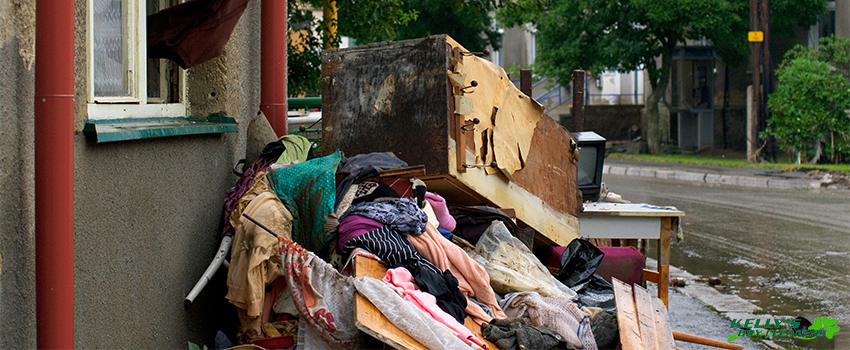In the United States, floods are considered one of the leading causes of weather-related deaths. Flash floods can run over a whole community in a snap, damaging properties, vehicles, and even the most valuable possessions, including clothes. So when we’re left with the disaster a flood has done, especially on our wearables, we’d need to know how to disinfect clothes and make them clean and crisp again.
The after-effects of natural disasters are always considered unfortunate events. However, the good thing is that there are ways to salvage clothing, upholstery, and textile seriously soiled by floods. You may be tempted to just search online for tips on how to restore damaged clothing after a flood, but the safest way to do this is by calling for expert help from your trusted dry cleaners.
The Danger of Flood Stains
A flood stain may look harmless at first, but such dirt presents serious health hazards. The Center for Disease and Prevention (CDC) warns everyone of the dangers of floodwaters. Flood or drain backup water may contain toxic chemicals and pathogenic microorganisms that may spread infectious diseases.
If your clothes and textile items come into contact with floodwater, usual laundering may not be enough to kill the bacteria and fungi that might be present on any flood stains. Bacteria can remain alive in fabrics even after the usual washing with detergent and water.
Fungal spores, on the other hand, should also be a cause to be wary. Flood-damaged clothing is prone to mildew formation, permanently damaging any type of textile quickly.
Types of Disinfecting Laundry Detergents
Does laundry detergent kill germs? The truth is, detergent alone can’t kill all the germs thriving on your clothing. Some bacteria and viruses can still survive even if you wash your clothes in hot water. Using hot water on clean clothes for a long period is also not advisable as it may fade colors and damage clothes.
Fortunately, there are disinfecting laundry detergents or laundry disinfectants designed to completely kill certain bacteria on your flood-damaged clothes. But it’s important to know that dealing with a flood stain is dangerous.
To avoid further damaging your clothes and putting your health at risk, let professional dry cleaners do the work for you. They will use a clothes sanitizer or laundry detergent that kills bacteria such as:
1. Liquid Chlorine Disinfectants
Sodium hypochlorite or chlorine bleach are commonly used to remove a persistent flood stain. A 5.25 to 6.15 percent concentration is considered effective when washing clothes using hot, warm, or cold water.
While not all chlorine bleach is that strong, it should always be diluted in water before adding it into the washer. Chlorine bleach is not suitable for washing spandex, silk, and wool. Pouring it directly onto the fabric can cause permanent damage.
2. Phenolic Disinfectants
Phenolic disinfectant is an alternative to chlorine bleach as it shows activity against viruses and bacteria when properly formulated. This disinfectant is most effective when used with hot or warm water when washing or rinsing off clothes.
3. Quaternary Disinfectants
Quaternary disinfectants are not commonly displayed in most stores, but they are an extremely effective product to disinfect clothes. These formulas can be used at any water temperature. Since a quaternary disinfectant contains strong ingredients, it is advisable to dilute it first with water or use only when rinsing.
4. Pine Oil Disinfectants
Research shows that adding pine oil to cleaners can result in a strong disinfectant effect against microbial organisms such as Staphylococcus aureus, Escherichia coli, Salmonella, etc. Products should contain at least 80% of pine oil to be deemed effective in cleaning flood stain and disinfecting clothes damaged by floodwaters. It’s recommended to be added at the start of the wash cycle using hot or warm water.
How to Disinfect Clothes
There are three important steps on how to disinfect laundry after major disasters such as a flood. Each step should be done carefully to ensure that the number of harmful bacteria is completely removed.
A professional dry cleaner is knowledgeable in the right water temperature, type of disinfectant, and cleaning process to wash clothes contaminated from a flood. Generally they:
1. Sort
To prevent contaminating clean clothes, it’s imperative to sort soiled clothes into piles away from uncontaminated clothes. When shaking contaminated clothes to remove flood debris and dirt, do this away from uncontaminated laundry or far from surfaces that will later be used for folding clean clothes.
The cover of carts of baskets used for sorting should be covered with clean paper or plastic. This is to prevent contamination when loading clean laundry.
2. Wash
Prevent mildew by washing flood-soiled clothes immediately. Add disinfectant to the wash water to effectively reduce the bacteria from your clothes. When using hot water, make sure that the temperature is within the recommended level to avoid damaging clothes. Rinse clothes multiple times in cool water until satisfied.
3. Dry
Before machine-drying or hang-drying, inspect clothes for stains. If there are remaining stains, soak the clothes overnight in water with oxygen-based bleach, then wash with regular detergent. Exposing the clothes to ultraviolet rays after machine-drying is also recommended to kill bacteria.
The American Cleaning Institute provided the following helpful tips on disinfecting clothes after flooding:
- After collecting salvageable clothes, scrape off any dirt or residue gently using physical tools.
- Do not use hot water when pre-washing clothes as it can cause stains to permanently set in. Put small loads of clothes on full water and rinse.
- Pour stain remover individually on persistent stains.
- Since clothes are contaminated with floodwater, add disinfectants along with effective powdered laundry detergent when washing clothes.
- Make sure to change rinsing water repeatedly when it becomes cloudy or dirty.
- Always ask professional help from a trusted dry cleaner when handling flood-contaminated clothes.
Trust Experts When Dealing With Contaminated Clothes
Clothes soiled by a flood can pose serious health risks. Trust only dry cleaners who are experts in dealing with water damage on your clothes.
Kelly’s Dry Cleaners offers fire damage and water damage restoration in Durango, CO. We respond quickly to this type of emergency and ensure that our cleaning procedures are meticulous, non-toxic, eco-friendly, and consider only your best interest. Call us today!



